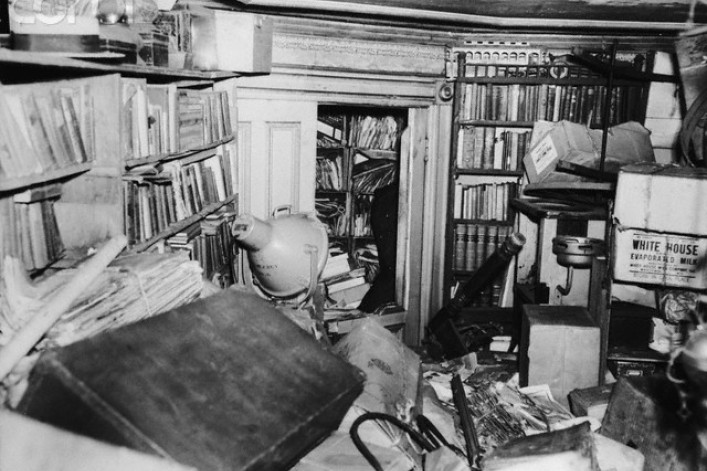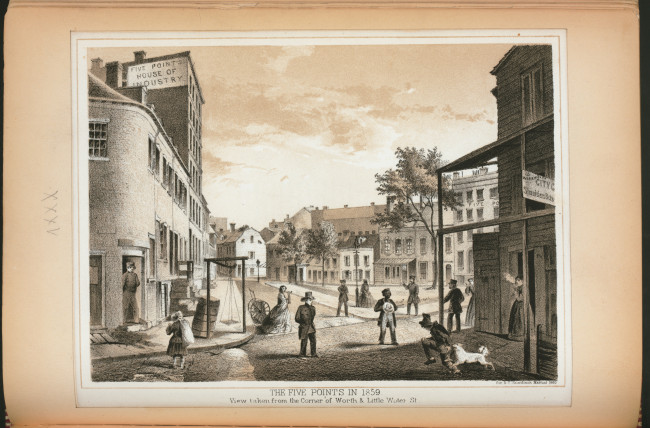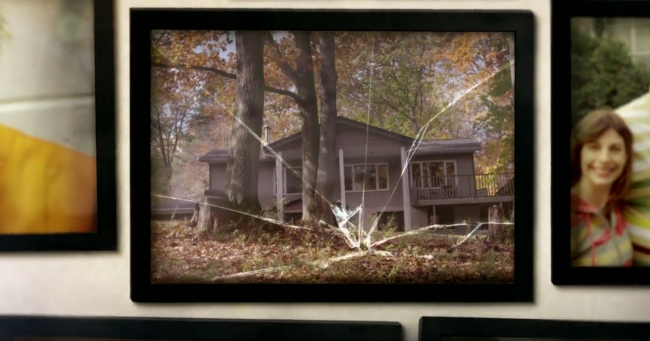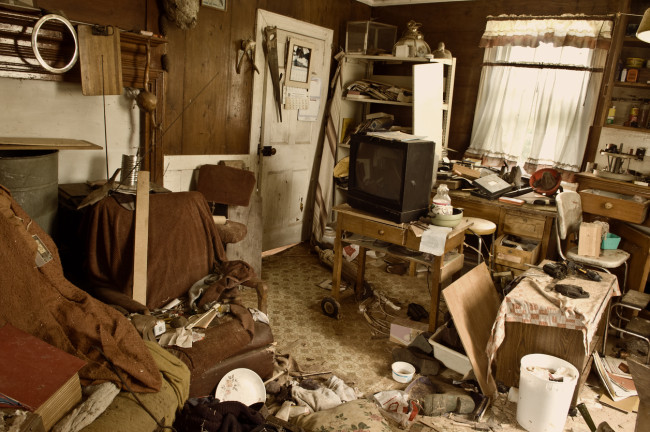Decades after the Collyer house raid, NYC is still obsessed with hoarders
On March 21, 1947, New York City police, acting on an anonymous tip, arrived at the brownstone at 128th and 5th in Harlem, home to Homer and Langley Collyer, a pair of by-then-notorious recluses. What they found was a house stuffed full with 140 tons of trash, including musical instruments, human organs preserved in jars, bowling balls, various booby traps, and underneath all the rubble, the bodies of brothers Homer and Langley, deceased among their own detritus.
Nearly seven decades later, New Yorkers are still fascinated by the two, and not without good reason: It was a juicy, lurid tabloid story. Long before the day the police knocked on (or rather, knocked down) their door, the wealthy, eccentric Collyers' had been the subject of plenty of interest in the city. Passersby stopped to gawk at their overflowing home, and according to the New York Sun, rumors persisted that they hoarded piles of money somewhere under all that junk. In fact, the high level of public interest is said to have made the problem worse, causing Homer and Langley to become paranoid (hence the booby traps). Harlem's transition into a predominantly African-American neighborhood during that time may have also been part of the reason the brothers holed themselves up from the outside world, as the New York Historical Society writes in When Did the Statue of Liberty Turn Green: and 101 Other Questions About New York City.
Whatever the reason, something about the story seems to have stuck. In the intervening years, the phrase "Collyers Mansion" has now become shorthand for an overstuffed hoarder house among firefighters all over the east coast, per the New York Times; high-profile journalist Franz Lidz wrote an entire book about the brothers; playwright Richard Greenberg's 2002 production, "The Dazzle," was inspired by them; and there's even a twee boutique named Collyer's Mansion in Brooklyn Heights that peddles a "curated and eclectic collection of items from around the globe." Search "Collyer brothers" on YouTube and you'll find a surprising number of tribute videos, most notably a short by an Australian filmmaker (below), who has also filmed himself touring the site of their former home in Harlem as well as their 2002 play by Richard Greenberg graves at the Cypress Hill Cemetery.
The hoarder next door
But while the Collyers have captured an outsized amount of the public's imagination, they're hardly the city's first (or last) high-profile hoarding case. In fact, even their relative wealth and good social standing isn't an anomaly: Recently, Kevin McRary, an Upper East Side "trust fund hoarder" has been in the news after an order to clear out of his apartment, and former president of the National Arts Club O. Alden James Jr. was ousted from the club over hoarding problems. Oddly enough, otherwise enviable housing situations have been more commonly associated with a burgeoning hoarding issue. "I’ve never been in any place that was really tiny that was a hoarder’s paradise," says BOND agent Mary Lou Currier, who herself has had several hoarder clients over the years. "They’ve been fairly large apartments—big two bedrooms,1,400 or 1,500 square feet." She also notes that it tends to be more common with residents who've been in a rent-stabilized apartment for decades and never had to move.
This is where the line can get blurry: if you're packing decades of life into a cramped New York apartment, keeping surfaces clear and spaces open is nothing if not an uphill battle for anyone. But a penchant for messiness and a genuine disorder are, indeed, two very different things—as a rule, the inability to use a room for its intended purposes (in other words, a kitchen or bathroom too packed with stuff to use for food prep or a proper shower) or refusal to have anyone over to your apartment are considered telltale signs that the problem has crossed the line into a serious condition.
And though voyeuristic interest in others' hoarding is hardly a phenomenon specific to New York (TLC has built an entire national TV empire around it, after all), in such close quarters, it can take on a different tenor. After all, far easier to ignore the garbage-filled house down the street than the garbage-filled apartment down the hall. "There’s definitely a huge fascination with it," says Dr. Lynn Saladino, a health and wellness consultant at Mirador Real Estate. "It’s such a visual representation that something is going on with a person."
And when hoarding problems reach the point of calling in the management or heading to court, it's almost always after neighbors have complained about pests or smells, says real estate attorney Steve Wagner. "You'd never know unless you live next to the person, and then it becomes very apparent, because of the odors as well as vermin and insects," he adds. "These cases are far more common than people believe."
Another reason a neighbor's compulsion can very much become your problem, too: Collyer apartments are a frequent cause of fires in apartment buildings. Even if a neighbor's clutter stays hidden behind closed doors, the risk of fires, coupled with the odors and pests (think roaches, rodents, bed bugs, and more) that can start permeating the rest of the building mean that someone else's hoarding can easily start interfering with safe and enjoyable use of the building's common spaces, or even your own apartment.
Stepping into a hoarder's proverbial shoes
Even when observed from afar, these stories can hit close to home, making you wonder if this could, yes, happen to you, too—who among us doesn't have a junk drawer or a few disorganized piles in the corner?—or that mountains of possessions could be lurking behind the doorways of people you know. "Everybody has pockets of hoarding in their lives," says Currier. "Sometimes it's books, sometimes it's clothes, sometimes it's saving every Playbill from every show you've seen since you came to the city in 1981."
And indeed, we've all heard stories of people who seemed perfectly fine to the outside world, but have a home filled with an oppressive stockpile of stuff. "There's often the assumption that these people are disheveled or dirty or not together, but with hoarders that is definitely not always the case," says Saladino. "This could absolutely be somebody who is out in the world functioning perfectly normally. You'd never know in a million years."
The mental health community is still trying to figure out how to best assess the problem (only recently have psychologists moved away from the theory that hoarding is related to Obsessive Compulsive Disorder, Saladino notes), and Wagner notes that senior-focused social services like JASA sometimes come into homes to help elderly people clear out clutter, and avoid losing their apartments altogether. Currier has also had clients hire professional organizers (to the tune of around $70/hour), saying, "Sometimes it works and sometimes it doesn't. They have to be very committed to changing."
Nationally, the problem is suprisingly prevalent—2010 numbers estimated between six million and 15 million Americans struggling with hoarding issues, as the New Yorker has reported. And though it isn't necessarily more common in NYC, our city's housing situation poses some unique challenges for hoarders, so much so that a New York City Hoarding task force was convened in the early aughts to determine how best to address the problem. (Manhattan agencies that work with older adults estimate that 10 percent of clients exhibited hoarding behvaior, according to Task Force findings, which also include helpful FAQs about warning signs and best practices when trying to help a hoarder.)
Moreover, a 2012 study out of Columbia University found that a disproportionately high rate of clients seeking help from Eviction Intervention Services Housing Research Center were in trouble over compulsive clutter—22 percent were rated as suffering from Hoarding Disorder and many were facing eviction, indicating that hoarding-related problems my actually be contributing to the city's burgeoning housing and homelessness crises.

As for the Collyers' old home? It was demolished after the city finally finished clearing out Homer and Langley's possessions, and has been a "pocket park" since 1965, and named after the brothers since the 1990s, though not without some degree of neighborhood controversy over its less-than-positive connotations. But even without an officially-sanctioned corner honoring their memory, it's not too likely the city is going to forget two of its most famous eccentrics anytime soon.
**This article first appeared on March 8, 2016.**
You Might Also Like































